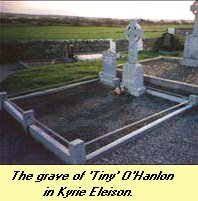|
'TINY' O'HANLON by Tom Shanahan His remains lie at rest in the family plot in the peaceful setting of Kyrie Eleison Cemetery, Abbeydorney. Apart from He was the tallest man that ever served in the Garda Siochana. He stood '7 3" in his boots and helmet, and 6' 10" in his bare feet. He did point duty at College Green for many years where he was photographed many times each day by visitors to the city. He was affectionately called "Tiny" by Dubliners. Very few people knew him by any other name. His untimely death at the early age of 37 years shortly before the outbreak of the last World War evoked feelings of widespread regret amongst the many who knew him in Dublin city and throughout the country. His name was Michael O'Hanlon and he was born at Ahabeg, Lixnaw, in the year 1901. He joined the DMP in 1922, shortly after the foundation of the Irish State, and after a period of training at Kevin Street Training Depot he was allocated to Pearse Street Station (then known as College Street). His unusual height made him an automatic choice for traffic duty at College Green and from then onwards he brought a new dimension to point duty by causing people to congregate daily in the vicinity of his point to watch his performance and his commanding appearance as his immaculately white gloves on his outstretched hands flashed their signals in the control of Dublin's traffic. People were entertained and fascinated by his performance. Children were entranced and captivated by this great giant standing in the centre of the swirling traffic. While tourist' cameras clicked and recorded his every movement. Dublin's traffic pointsmen have always taken a special pride in their work and every experienced pointsman develops his own individual style which he will not swop with anybody else. He develops this skill after years of practice in all types of weather. "Tiny's" style, like himself, was unique. He was regarded by his colleagues as a perfectionist. All his signals appeared efficient, determined and easy to understand. Every movement of his hands and feet was deliberately controlled from the moment he took up duty.. He approached his point with the solemnity of the conductor of an orchestra. . One particular aspect of his traffic control which the public found most entertaining was known to his colleagues as the "Tiny Flick". This occurred when he was about to halt traffic. He would take two paces forward, select the fourth or fifth vechicle in a line of traffic, fix his eyes on the driver and with a slow deliberate movement bring his right hand up in front of him, reaching a height of almost nine feet from ground level, holding the hand rigid in this position with flashing white glove until the vehicle had come to a halt in front of him. This movement of his right hand gave every driver of a vehicle adequate warning and was much appreciated. It was performed with such solemnity, skill and sincerity of purpose that everybody who watched him could not but be enchanted by the craftsmanship of his great outstretched hand. Tiny also ensured that pedestrians received his personal consideration, and he always made certain to allow them an adequate period for movement when they assembled on the edges of the footway adjacent to his point. He had a soft spot in his heart for Dublin's senior citizens and they were grateful to him for the assistance which he generously gave them. When Tiny was off duty Dubliners easily recognised him as a result of his singular height. They always saluted and hailed him in the way that only Dubliners can. To the children he was always the traffic giant. On 7th February, 1936, Tiny was promoted to the rank of Sergeant. He was the first of only two Sergeants promoted to that rank in Dublin that year. His promotion was widely acclaimed. Tiny remained attached to the Traffic Department and took a special interest in the training of young pointsmen. In the early spring of 1938 he was taken ill. He died on 6th march, 1938, shortly after the second anniversary of his promotion to the rank of Sergeant. His funeral one of the biggest ever seen in Dublin and attended by people from all walks of life. As the funeral party passed through College Green, O'Connell Street, Bachelor's Walk and through the Quays on its way to Abbeydorney, tram cars, and all vehicular traffic came to a standstill as a final mark of respect to Dublin's most famous traffic pointsman, who in all types of weather gave his best to keeping traffic moving safely in the city. As I stood in Kyrie Eleison Cemetary on that cold March day and watched his young body been lowered into the family grave, I could hear persons around me talking in hushed tones about the terrible scourage of tuberculosis. They were wondering if a cure would ever be found for it. |
 members of the older generation few Abbeydorney people today would remember his name. But "Tiny" was a living legend in the Garda Siochana of the twenties and thirties and to a generation of Dubliners he was as familiar a city landmark as the Nelson's Pillar or the Custom House.
members of the older generation few Abbeydorney people today would remember his name. But "Tiny" was a living legend in the Garda Siochana of the twenties and thirties and to a generation of Dubliners he was as familiar a city landmark as the Nelson's Pillar or the Custom House.